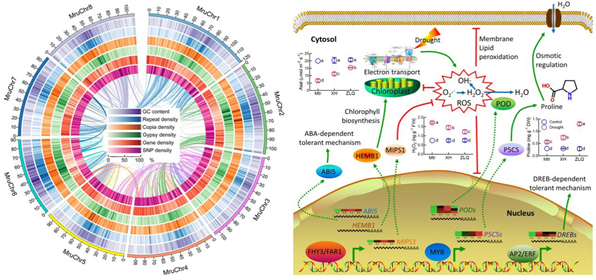Medicago ruthenica, a wild and perennial legume forage widely distributed in semi-arid grasslands, is distinguished by its outstanding tolerance to environmental stress. It is a close relative of commonly cultivated forage of alfalfa (Medicago sativa). The high tolerance of M. ruthenica to environmental stress makes this species a valuable genetic resource for understanding and improving traits associated with tolerance to harsh environments.
Scientists from the Institute of Botany of the Chinese Academy of Sciences (CAS), together with their collaborators, sequenced and assembled genome of M. ruthenica using an integrated approach, including PacBio, Illumina, 10×Genomics and Hi-C. The assembled genome is 904.13 Mb with scaffold N50 of 99.39 Mb, and 50,162 protein-coding genes are annotated.
They elucidate mechanisms underlying the tolerance of M. ruthenica to environmental stress by comparative genomics and transcriptomic analyses. They discover that expanded FHY3/FAR1 family is involved in tolerance of M. ruthenica to drought stress.
They find that many genes involved in tolerance to abiotic stress are retained in M. ruthenica compared to other cultivated Medicago species. They identify hundreds of candidate genes associated with drought tolerance by analyzing variations in single nucleotide polymorphism using accessions of M. ruthenica with varying tolerance to drought. Transcriptomic data reveal the involvements of genes related to transcriptional regulation, stress response and metabolic regulation in tolerance of M. ruthenica.
“The high quality genome assembly and identification of drought-related genes in the wild species of M. ruthenica provide a valuable resource for genomic studies on perennial legume forages,” said Prof. ZHANG Wen-Hao, correspondence author of the study.
This study has been published online in the journal BMC Biology.

Distribution of genomic features within the M. ruthenica genome and proposed mechanisms behind tolerance of M. ruthenica to drought stress (Image by WANG Tianzuo)
Article link: https://bmcbiol.biomedcentral.com/articles/10.1186/s12915-021-01033-0
Contact Info:
Email: whzhang@ibcas.ac.cn
Institute of Botany, Chinese Academy of Sciences
Medicago ruthenica, a wild and perennial legume forage widely distributed in semi-arid grasslands, is distinguished by its outstanding tolerance to environmental stress. It is a close relative of commonly cultivated forage of alfalfa (Medicago sativa). The high tolerance of M. ruthenica to environmental stress makes this species a valuable genetic resource for understanding and improving traits associated with tolerance to harsh environments.
Scientists from the Institute of Botany of the Chinese Academy of Sciences (CAS), together with their collaborators, sequenced and assembled genome of M. ruthenica using an integrated approach, including PacBio, Illumina, 10×Genomics and Hi-C. The assembled genome is 904.13 Mb with scaffold N50 of 99.39 Mb, and 50,162 protein-coding genes are annotated.
They elucidate mechanisms underlying the tolerance of M. ruthenica to environmental stress by comparative genomics and transcriptomic analyses. They discover that expanded FHY3/FAR1 family is involved in tolerance of M. ruthenica to drought stress.
They find that many genes involved in tolerance to abiotic stress are retained in M. ruthenica compared to other cultivated Medicago species. They identify hundreds of candidate genes associated with drought tolerance by analyzing variations in single nucleotide polymorphism using accessions of M. ruthenica with varying tolerance to drought. Transcriptomic data reveal the involvements of genes related to transcriptional regulation, stress response and metabolic regulation in tolerance of M. ruthenica.
“The high quality genome assembly and identification of drought-related genes in the wild species of M. ruthenica provide a valuable resource for genomic studies on perennial legume forages,” said Prof. ZHANG Wen-Hao, correspondence author of the study.
This study has been published online in the journal BMC Biology.

Distribution of genomic features within the M. ruthenica genome and proposed mechanisms behind tolerance of M. ruthenica to drought stress (Image by WANG Tianzuo)
Article link: https://bmcbiol.biomedcentral.com/articles/10.1186/s12915-021-01033-0
Contact Info:
Email: whzhang@ibcas.ac.cn
Institute of Botany, Chinese Academy of Sciences
